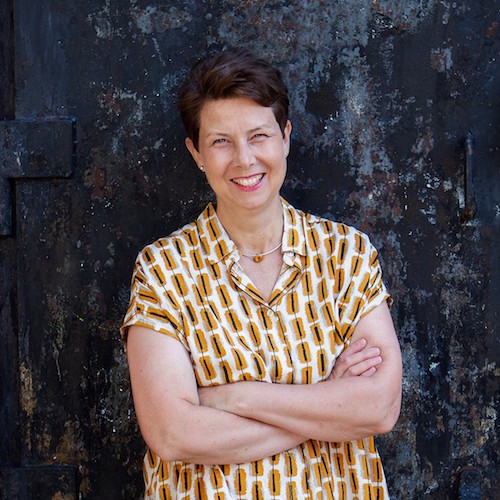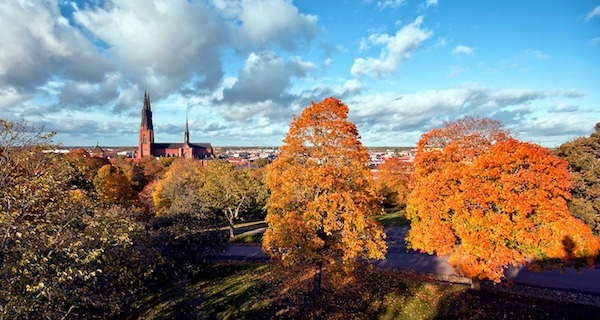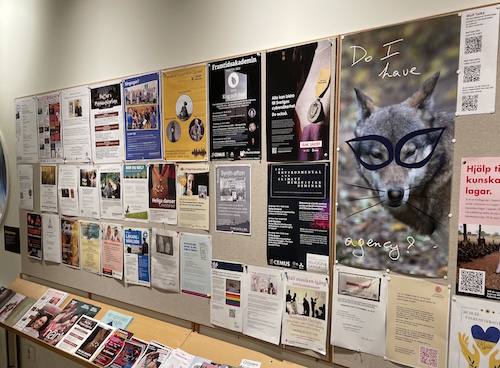Interview with Elisabeth Wennerström
Wolf Talks in Sweden

Thank you, Elisabeth, for joining us in our Autumn 2022 Newsletter. Before we start to talk about the Wolf Talks exhibit in Sweden and your work in this exhibit, could you tell us a bit about yourself, your work, your studies?
Elisabeth: I have always been curious about research. After years of working with media and communications for the performing arts, I decided to pursue a master’s degree in social sciences with an emphasis on digital media and society. Then I learned about the Erasmus+ traineeship that Uppsala university encourages students to pursue following the master’s programme, and I reached out to Nico Carpentier, who is the Extraordinary Professor at Charles University at the Institute of Communication Studies and Journalism. I asked if I could work as an assistant at the Institute to gain professional experience and contact with more researchers. The answer was positive! As part of the traineeship, I help to organize, and bring, the Wolf Talks exhibit to Sweden. Additionally, I will conduct focus group sessions and conduct observations for a reception study on the exhibit.
Could you tell us a bit more about the Wolf Talks?
Elisabeth: About two years ago, the Wolf Talks project was created by communications researcher Nico Carpentier, under the umbrella of the media and arts project Silencing/Unsilencing Nature at the Institute for Communication Studies and Journalism at Charles University in Prague, where also more media and the arts projects relate within the Silencing/Unsilencing Nature project, as part of the Mistra Environmental Communication Research Programme. Wolf Talks was presented as an exhibit in Prague last Fall, and in Pakistan earlier this year. Now it is presented in Uppsala, Sweden.
The Wolf Talks exhibit explores power hierarchies between human and non-human animals, to show how nature has often been silenced. While the Wolf Talks exhibit starts out by pointing to the position of wolves in the zoo assemblage, it doesn't linger there for long. Rather, it quickly resets the focal point, from a broader spectrum of representations and positions, to which these animals have long been discursively and materially entrapped.
Sounds quite interesting! Could you inform us a bit more about the exhibition, when and where will the Wolves be exhibited?
Elisabeth: Similarly to the installation in Prague last Fall, the Uppsala exhibit is held at different locations in the city centre, running between October 24 and November 5, 2022.
The twelve Wolf Talks images are exhibited to general audiences, in shopping windows and on bulletin boards, for easy access to pedestrians in the city centre. Still, the idea of exhibiting the photos is not just to encourage a nice walk. It is also about placing these images in a city context, to resist and expand on the wolves’ reach, and equally of the location of an art exhibit.
So, people visiting the city center will find themselves inside the exhibition without even knowing that?
Elisabeth: Yes, it is an opportunity to present an exhibit in such unexpected places. In part, it may allow more audiences to discover it, and to take part also. Finding that mix is central.

This brings us to my next question. Could you tell us a bit about the interactive and participatory components of Wolf Talks in Sweden? What expects the audience at the exhibit?
Elisabeth: Wolf Talks is displayed as an interactive sound and image installation. It includes photos of wolves from the Prague Zoo. Each of the images are layered with cat filters, and there is a theoretical question superimposed onto each image, questions that the wolves pose to us, human animals. It might come as a surprise, perhaps a challenge too, but they are quite smart…
Next to the image is a QR code that allows the visitor to reach the website for Wolf Talks and listen to one of the Wolf Talks. The wolves are talking back, responding to the theoretical questions written onto the images.
So, the exhibit is interactive through the mixed layers of photographs, cat filters, and theoretical questions (including the wolves’ answers) that the visitor can listen to through the QR code. Also, the visitor can interact with the wolves on the website, to ask a question, or to respond. You can write your own Wolf Talk! The visitors’ added questions and Wolf Talks are reviewed and posted accordingly on the Wolf Talk website.
Curious to hear about what will come out! Are there any activities planned in scope of the exhibit?
Elisabeth: As part of the Wolf Talks exhibit, we will conduct a reception study. We are inviting civil society organisations with a broad interest in environmental communication to take part in focus groups, as non-governmental and non-profit organizations with environmental programs and members of their own in the Uppsala region.
In this way, the exhibit not only involves sharing Wolf Talks with general audiences, but also shares it with practitioner members from civil society organisations, who are themselves knowledgeable and engaged in the topic of the exhibit.

What is it like to work with researchers on an art exhibit, and to organize an event bringing research and arts together?
Elisabeth: That's a good question! In terms of organizing events, participatory considerations, and finding the project’s ”sweet spot”, i.e. the right balance to invite audiences are always central.
In terms of exhibiting art-based research, it allows different audiences to engage with research in new ways than in a lecture or in an academic article. Of course, those avenues for sharing research are central. But to also engage with and and elucidate new research from artistic creations, it also means potential new research as well as new exchanges with audiences. Wolf Talks is an example of that, where we are doing both.
So, you are in contact with different organisations to inform them about the exhibition and invite them to join the “talks”. How are their reactions so far?
The Wolf Talks exhibit builds on local liaisons, contacts, and collaborations. The shop and property owners, cafés, the university student union, and more of our exhibit windows and bulletin boards – local partners in the Wolf Talks exhibit – have expressed their sincere appreciation. In bringing the exhibit to Sweden, this has been particularly heartfelt to me as I have worked on the exhibit. Also, being part of a research team at the Institute of Communications Studies and Journalism at Charles university, provided me with a supportive environment, from which to introduce and offer this opportunity to these local partners – also for me as a research trainee. We are all appreciating the interest of the Wolf Talks societal partners, and happy to see the exhibit attracts such a broad interest.
Thank you very much, Elisabeth. It was a very nice conversation. Congratulations already, and good luck with the exhibition!
Elisabeth: Thank you.